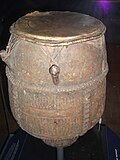Ashanti Empire
The Asante Empire (Asante Twi: Asanteman), today commonly called the Ashanti Empire, was an Akan state that lasted from 1701 to 1901, in what is now modern-day Ghana. It expanded from the Ashanti Region to include most of Ghana and also parts of Ivory Coast and Togo.
Ashanti Empire Asanteman (Asante Twi) | |||||||||||||
|---|---|---|---|---|---|---|---|---|---|---|---|---|---|
| |||||||||||||
 Map of the Ashanti Empire | |||||||||||||
| Status | State union | ||||||||||||
| Capital | Kumasi | ||||||||||||
| Common languages | Ashanti (Twi) (official) | ||||||||||||
| Religion | Initially Akan religion, later also Christianity | ||||||||||||
| Government | Monarchy | ||||||||||||
• 1670–1717 (first) | Osei Tutu | ||||||||||||
• 1888–1896 (13th) | Prempeh I | ||||||||||||
• 1931–1957 (last) | Prempeh II | ||||||||||||
| Osei Tutu II | |||||||||||||
| Legislature | Asante Kotoko (Council of Kumasi)[1] and the Asantemanhyiamu (National Assembly) | ||||||||||||
| History | |||||||||||||
• | 1701 | ||||||||||||
• Independence from Denkyira | 1701 | ||||||||||||
• Annexed to form a British colony named Ashanti | 1901[2] | ||||||||||||
• Self-rule | 1935 | ||||||||||||
• State union as Ashanti Region with Ghana | 1957 | ||||||||||||
• | Present | ||||||||||||
| Area | |||||||||||||
| [3] | 259,000 km2 (100,000 sq mi) | ||||||||||||
| Population | |||||||||||||
• | 3,000,000 | ||||||||||||
| Currency |
| ||||||||||||
| |||||||||||||
| Today part of | Ghana
Ivory Coast Togo | ||||||||||||
Ashanti Empire Media
Golden Stool (Sika dwa) in the Asante Kingdom, 1935
English officers selecting quarters in the chief's palace at Fomena.
The Asante army engaged with British forces under the command of Col. Sutherland, July 11, 1824
An Asante force engaged with the British 42nd Highlanders; The Graphic.
Queen Yaa Asantewaa led her state, Ejisu, in the War of the Golden Stool against the British.
References
- ↑ Edgerton, Robert B. Fall of the Asante Empire: The Hundred Year War for Africa's Gold Coast. Free Press, 1995.
- ↑ Ashanti Order in Council 1901.
- ↑ Iliffe, John (1995). Africans: The History of a Continent. Cambridge University Press. p. 143. ISBN 9780521484220.






